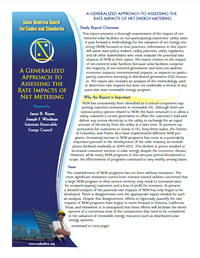A Generalized Approach to Assessing the Rate Impacts of Net Energy Metering
Download the one-page summary (PDF, 411KB) or the full report (PDF, 918KB).
Overview

Why the Report is Important
NEM has consistently been identified as a critical component supporting customer investment in renewable DG. Although there are various policy options related to NEM, the basic structure is to allow a utility customer's on-site generation to offset the customer's load and deliver any excess electricity to the utility in exchange for an equal amount of electricity from the utility at a later time. To promote opportunities for customers to invest in DG, forty-three states, the District of Columbia, and Puerto Rico have implemented different NEM programs. Increasing interest in NEM programs has come at a particularly important juncture in the development of the solar industry as module prices declined markedly in 2009-2010. This decline in prices resulted in increased consumer interest in solar energy despite the economic climate. However, while many NEM programs in this two-year period broadened in scope, the effectiveness of programs continued to vary widely among states.
Issue
The establishment of NEM programs has not been without resistance. The most significant resistance comes from investor-owned utilities concerned that a large NEM program in their service territory may result in increased rates for nonparticipating customers and a loss of profit for investors. At present, a detailed analysis of the potential rate impacts of NEM has only begun to be developed. There is disagreement over the appropriate inputs needed for such an analysis. Despite this disagreement, efforts to rigorously quantify the rate impacts of NEM programs have begun to move forward in Arizona, California, Texas, and elsewhere. It is anticipated that these efforts will facilitate the development of a consensus view of the components that need to be considered in the valuation of renewable energy resources such as distributed solar energy systems.
